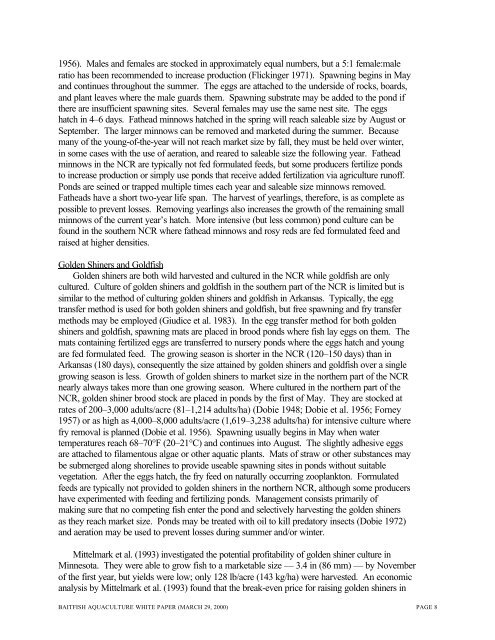a white paper on the status and needs of baitfish ... - NCRAC
a white paper on the status and needs of baitfish ... - NCRAC
a white paper on the status and needs of baitfish ... - NCRAC
Create successful ePaper yourself
Turn your PDF publications into a flip-book with our unique Google optimized e-Paper software.
1956). Males <strong>and</strong> females are stocked in approximately equal numbers, but a 5:1 female:male<br />
ratio has been recommended to increase producti<strong>on</strong> (Flickinger 1971). Spawning begins in May<br />
<strong>and</strong> c<strong>on</strong>tinues throughout <strong>the</strong> summer. The eggs are attached to <strong>the</strong> underside <strong>of</strong> rocks, boards,<br />
<strong>and</strong> plant leaves where <strong>the</strong> male guards <strong>the</strong>m. Spawning substrate may be added to <strong>the</strong> p<strong>on</strong>d if<br />
<strong>the</strong>re are insufficient spawning sites. Several females may use <strong>the</strong> same nest site. The eggs<br />
hatch in 4–6 days. Fa<strong>the</strong>ad minnows hatched in <strong>the</strong> spring will reach saleable size by August or<br />
September. The larger minnows can be removed <strong>and</strong> marketed during <strong>the</strong> summer. Because<br />
many <strong>of</strong> <strong>the</strong> young-<strong>of</strong>-<strong>the</strong>-year will not reach market size by fall, <strong>the</strong>y must be held over winter,<br />
in some cases with <strong>the</strong> use <strong>of</strong> aerati<strong>on</strong>, <strong>and</strong> reared to saleable size <strong>the</strong> following year. Fa<strong>the</strong>ad<br />
minnows in <strong>the</strong> NCR are typically not fed formulated feeds, but some producers fertilize p<strong>on</strong>ds<br />
to increase producti<strong>on</strong> or simply use p<strong>on</strong>ds that receive added fertilizati<strong>on</strong> via agriculture run<strong>of</strong>f.<br />
P<strong>on</strong>ds are seined or trapped multiple times each year <strong>and</strong> saleable size minnows removed.<br />
Fa<strong>the</strong>ads have a short two-year life span. The harvest <strong>of</strong> yearlings, <strong>the</strong>refore, is as complete as<br />
possible to prevent losses. Removing yearlings also increases <strong>the</strong> growth <strong>of</strong> <strong>the</strong> remaining small<br />
minnows <strong>of</strong> <strong>the</strong> current year’s hatch. More intensive (but less comm<strong>on</strong>) p<strong>on</strong>d culture can be<br />
found in <strong>the</strong> sou<strong>the</strong>rn NCR where fa<strong>the</strong>ad minnows <strong>and</strong> rosy reds are fed formulated feed <strong>and</strong><br />
raised at higher densities.<br />
Golden Shiners <strong>and</strong> Goldfish<br />
Golden shiners are both wild harvested <strong>and</strong> cultured in <strong>the</strong> NCR while goldfish are <strong>on</strong>ly<br />
cultured. Culture <strong>of</strong> golden shiners <strong>and</strong> goldfish in <strong>the</strong> sou<strong>the</strong>rn part <strong>of</strong> <strong>the</strong> NCR is limited but is<br />
similar to <strong>the</strong> method <strong>of</strong> culturing golden shiners <strong>and</strong> goldfish in Arkansas. Typically, <strong>the</strong> egg<br />
transfer method is used for both golden shiners <strong>and</strong> goldfish, but free spawning <strong>and</strong> fry transfer<br />
methods may be employed (Giudice et al. 1983). In <strong>the</strong> egg transfer method for both golden<br />
shiners <strong>and</strong> goldfish, spawning mats are placed in brood p<strong>on</strong>ds where fish lay eggs <strong>on</strong> <strong>the</strong>m. The<br />
mats c<strong>on</strong>taining fertilized eggs are transferred to nursery p<strong>on</strong>ds where <strong>the</strong> eggs hatch <strong>and</strong> young<br />
are fed formulated feed. The growing seas<strong>on</strong> is shorter in <strong>the</strong> NCR (120–150 days) than in<br />
Arkansas (180 days), c<strong>on</strong>sequently <strong>the</strong> size attained by golden shiners <strong>and</strong> goldfish over a single<br />
growing seas<strong>on</strong> is less. Growth <strong>of</strong> golden shiners to market size in <strong>the</strong> nor<strong>the</strong>rn part <strong>of</strong> <strong>the</strong> NCR<br />
nearly always takes more than <strong>on</strong>e growing seas<strong>on</strong>. Where cultured in <strong>the</strong> nor<strong>the</strong>rn part <strong>of</strong> <strong>the</strong><br />
NCR, golden shiner brood stock are placed in p<strong>on</strong>ds by <strong>the</strong> first <strong>of</strong> May. They are stocked at<br />
rates <strong>of</strong> 200–3,000 adults/acre (81–1,214 adults/ha) (Dobie 1948; Dobie et al. 1956; Forney<br />
1957) or as high as 4,000–8,000 adults/acre (1,619–3,238 adults/ha) for intensive culture where<br />
fry removal is planned (Dobie et al. 1956). Spawning usually begins in May when water<br />
temperatures reach 68–70°F (20–21°C) <strong>and</strong> c<strong>on</strong>tinues into August. The slightly adhesive eggs<br />
are attached to filamentous algae or o<strong>the</strong>r aquatic plants. Mats <strong>of</strong> straw or o<strong>the</strong>r substances may<br />
be submerged al<strong>on</strong>g shorelines to provide useable spawning sites in p<strong>on</strong>ds without suitable<br />
vegetati<strong>on</strong>. After <strong>the</strong> eggs hatch, <strong>the</strong> fry feed <strong>on</strong> naturally occurring zooplankt<strong>on</strong>. Formulated<br />
feeds are typically not provided to golden shiners in <strong>the</strong> nor<strong>the</strong>rn NCR, although some producers<br />
have experimented with feeding <strong>and</strong> fertilizing p<strong>on</strong>ds. Management c<strong>on</strong>sists primarily <strong>of</strong><br />
making sure that no competing fish enter <strong>the</strong> p<strong>on</strong>d <strong>and</strong> selectively harvesting <strong>the</strong> golden shiners<br />
as <strong>the</strong>y reach market size. P<strong>on</strong>ds may be treated with oil to kill predatory insects (Dobie 1972)<br />
<strong>and</strong> aerati<strong>on</strong> may be used to prevent losses during summer <strong>and</strong>/or winter.<br />
Mittelmark et al. (1993) investigated <strong>the</strong> potential pr<strong>of</strong>itability <strong>of</strong> golden shiner culture in<br />
Minnesota. They were able to grow fish to a marketable size — 3.4 in (86 mm) — by November<br />
<strong>of</strong> <strong>the</strong> first year, but yields were low; <strong>on</strong>ly 128 lb/acre (143 kg/ha) were harvested. An ec<strong>on</strong>omic<br />
analysis by Mittelmark et al. (1993) found that <strong>the</strong> break-even price for raising golden shiners in<br />
BAITFISH AQUACULTURE WHITE PAPER (MARCH 29, 2000) PAGE 8


